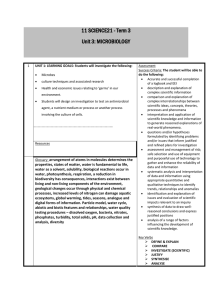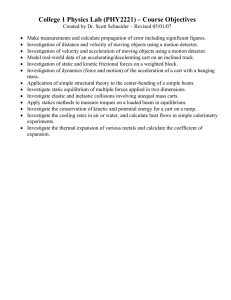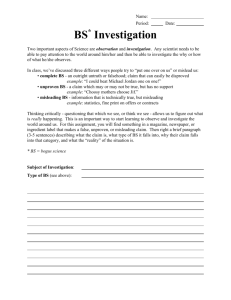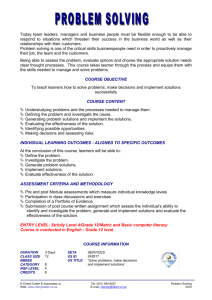Content www.XtremePapers.com
advertisement
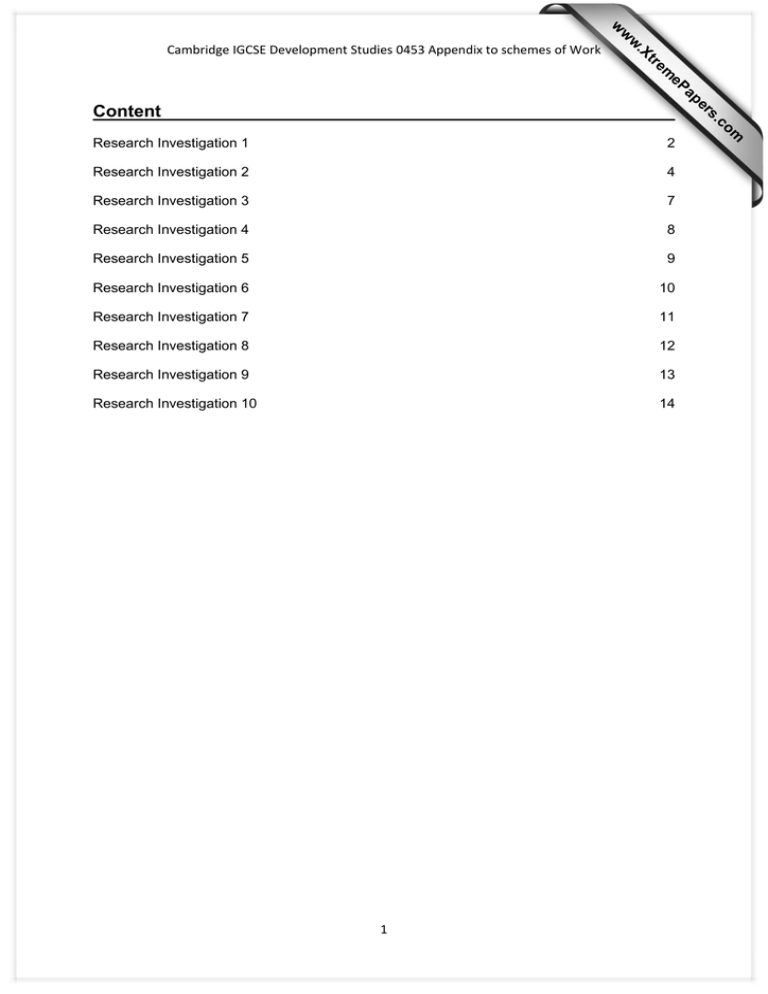
w w m e tr .X w Cambridge IGCSE Development Studies 0453 Appendix to schemes of Work ap eP Research Investigation 1 2 Research Investigation 2 4 Research Investigation 3 7 Research Investigation 4 8 Research Investigation 5 9 Research Investigation 6 10 Research Investigation 7 11 Research Investigation 8 12 Research Investigation 9 13 Research Investigation 10 14 1 om .c s er Content Cambridge IGCSE Development Studies 0453 Appendix to schemes of Work Research Investigation 1____________________________________ Relationship between different indicators of development 1.1 Aim To select two indicators of development and investigate to what extent there is a relationship between them and reasons for it. 1.2 Objectives 1. To select a sample of countries at varying stages of development. 2. To choose appropriate indicators of development that may show a relationship. 3. To represent the data in appropriate forms. 4. To investigate to what extent there is a (perfect) positive/negative relationship. 5. To give reasons for the relationship. 6. To attempt to explain anomalies. 1.3 Method • Table of GNP per person for all countries from Internet/books research. • Use an appropriate sampling technique to select a useful number of countries at varying stages of development. • Choose two indicators of development and find these statistics for the countries sampled above. • Represent the data in the most appropriate way to show the relationship between them. 1.4 Syllabus units and general objectives addressed Poverty and development: general objective 2 1.5 The investigation For example the following sections could be included. TITLE E.g. Research Investigation into the relationship between life expectancy and the % of people employed in agriculture in countries at varying stages of development. INTRODUCTION A brief introduction might include comments such as the fact that the standard of living of a country’s citizens is largely related to the country’s wealth. Aspects of educational attainment, health, employment etc. can be measured and statistics compared between countries as well as in the same country over time and progress towards achieving the Millennium Development Goals can be assessed. Indicators of development are often related as the more economically developed a country is, the more money it has to invest in healthcare, education etc. RESEARCH QUESTION/H-YPOTHESIS E.g. Research Question: Does life expectancy have a negative correlation with the % employed in agriculture in a country? OR 2 Cambridge IGCSE Development Studies 0453 Appendix to schemes of Work E.g. Hypothesis to be tested/prediction/expectation: Life expectancy and the % employed in agriculture do not show a perfect negative correlation. METHODS OF DATA COLLECTION The most appropriate methods to be used to collect the data need to be considered. In the write-up for this investigation, it will be necessary to discuss the merits of different sampling techniques and which method is most appropriate for this particular task. The sample size must also be considered. Depending on the source of the data, it may be necessary to rank the countries in order of GNP per person. A systematic sample could then be obtained to ensure data from countries at all levels of development were included. A discussion of the advantages and disadvantages of using GNP per person as an indicator of development may be useful. For the countries sampled, statistics of the chosen indicators of development need to be found. The reasons for the choice of method of data representation need to be considered. DATA REPRESENTATION A scatter graph and choropleth maps can be used to represent the data. ANALYSIS The analysis will include a discussion as to whether the relationship is positive or negative as well as how perfect the correlation is. There may be no correlation shown at all between the two sets of data, or there may be too many anomalies to make any firm conclusion. With the example given, a negative correlation would be apparent, but this is unlikely to be perfect and there may be some anomalies. Reasons for the relationship need to be given, such as, countries with high levels of employment in the agricultural sector produce primary goods which do not have high value when exported. The country’s income is therefore low and it cannot invest large sums of money in education and health services. Therefore many people are uneducated and do not know the advantages of a balanced diet and how to prevent diseases, and when they become ill there are no available medical facilities. This leads to a low life expectancy. Also farmers’ incomes are low and so they cannot afford a varied diet or to send their children to school. It may be possible to explain some of the anomalies, or at least give some suggestions as to why some countries do not fit the overall pattern. CONCLUSION Reference back to the original aim and research question/hypothesis should be made, with the question answered or the hypothesis accepted or rejected. EVALUATION This may consider how the methods of data collection could be improved and whether or not the methods of data representation were the most appropriate. Other relationships for study could be suggested. EXTENSION An interesting follow-up exercise would be to repeat the investigation, but using different sampling techniques, and comparing the results. 3 Cambridge IGCSE Development Studies 0453 Appendix to schemes of Work Research Investigation 2____________________________________ Links between different sectors of the economy 1.1 Aim To consider the links between a commercial farm and activities in other sectors of the economy. This investigation could easily be adapted to consider the links between a manufacturing industry and other sectors of the economy. 1.2 Objectives 1. To identify the different land uses on a local farm. 2. To identify the inputs and their source. 3. To investigate the production process. 4. To identify the outputs and their destination. 5. To consider the ways the inputs/outputs are delivered/ distributed. 6. To investigate the % employed in the different sectors of the economy in the country. 1.3 Method • Land use mapping and field sketches. • Use of secondary data/local knowledge to map transport infrastructure, local settlements etc. • Interview/questionnaire for farmer. • Use of the Internet/books to find national statistics for employment. 1.4 Syllabus units and general objectives addressed Industrial development, trade and globalisation: general objective 1 Environment and development: general objective 1 1.5 The investigation For example the following sections could be included. TITLE E.g. Research Investigation into the links between a commercial maize farm and other sectors of the economy. INTRODUCTION A brief background to the topic would include a rationale for the investigation including an explanation of the need to consider links between different sections of the economy as they are all interdependent. Reasons for the choice of farm to study should also be made clear. RESEARCH QUESTION/HYPOTHESIS E.g. A research question – How important are the links between a commercial farm production and other sectors of the economy? E.g. a hypothesis to test – Commercial farm production is totally dependent on other parts of the primary sector as well as the secondary and tertiary sectors of the economy. 4 Cambridge IGCSE Development Studies 0453 Appendix to schemes of Work METHODS OF DATA COLLECTION – these would be written up in a methodology in the final report, explaining how the fieldwork was undertaken, problems encountered and possible solutions. Mapping of the farm to include the use of buildings as well as land, with annotations as appropriate. Use of secondary data/local knowledge to draw a sketch map of local transport infrastructure and settlements. Drawing of field sketches of anything relevant to the investigation. Devising a series of questions to ask the farmer in an interview, or writing a list for completion in his/her own time. A discussion of the relative merits of the different approaches needs to be included in the write-up of this investigation. The questionnaire could be evaluated and the value of a ‘pilot’ discussed. Questions: 1. What inputs are always on the farm and used to produce the output? (land, soil, weather conditions, machinery, computers, labour, breeding stock, seeds from previous year, manure etc.) 2. What inputs are regularly brought in, from where and how? (new seed, livestock, fertilisers, pesticides, herbicides, fuel, labour etc.) 3. What inputs are occasionally brought in, from where and how? (new machinery, advice from Agricultural Extension Officers/ Rural Dev. Agency etc.) 4. What are the main processes on the farm? 5. What are the outputs, to where are they sent and for what purpose? (milk/crops for local processing, milk/meat/crops/for local named markets/export, waste etc.) Finding national statistics of % employment in different sectors of the economy. The most appropriate way to represent this data needs to be explained. DATA REPRESENTATION Detailed farm plan. Devise a suitable key together with some reference to scale. Larger scaled map of local surroundings to show location of farm in relation to transport infrastructure and settlements as sources of labour, markets etc. Overlays could be used to indicate the flow of inputs and outputs. Annotated sketches of carts, lorries, farm tools etc. Detailed flow chart showing all the factors of production, with colour coding for the different sectors of the economy. Pie chart/triangular graph/divided bar to show % employed in the different sectors of their economy. ANALYSIS This may be best divided into links with the three main sectors of the economy, to relate it directly to the original aim and hypothesis. 5 Cambridge IGCSE Development Studies 0453 Appendix to schemes of Work Primary Sector – this may involve a discussion about sources of seed/stock from other parts of the agricultural sector as well as fuel from the extractive primary industry. The fact that farmers need food to eat themselves in order to keep healthy to work may be noted. Secondary Sector – if the output is processed, then this is a major forward link with the secondary sector of the economy. The links may be less obvious, such as the secondary sector providing the machines/tools/buildings/irrigation pumps/pesticides etc. for the production process. Tertiary Sector- it may be emphasised here that production is no good to the commercial farmer unless he can sell the produce. So distribution to the points of sale relies not only on the road/rail infrastructure but also on transport services. Communication via telephone or the Internet may determine markets, as may the use of advertising. There must be shops/markets, all part of the tertiary sector. The supply of utilities such as electricity and water also needs to be considered. An extension of the analysis could include consideration of more hidden elements of the tertiary sector. E.g. the skills the farmer uses may have been learnt at an agricultural college or in workshops provided by the local co-operatives. The efficiency of his/her workers will depend on their health, which can be improved through access to local Primary Health Care. Security may be an issue which requires input from the police service. The greater the income from the sale of produce, the more money that can be spent in the local economy, which will result in the development of new/better services as people’s standards of living improve. CONCLUSION A brief summary of the findings will lead to reference back to the original research question or hypothesis. The question can be answered or the hypothesis can be accepted or rejected on the basis of the evidence collected. EVALUATION The evaluation of the investigation needs to consider whether or not the aim has been achieved. It needs to include a section on the problems encountered and how these could be minimised in a future investigation. Improvements can be suggested for methods of data collection. The value of the study may also be considered. 6 Cambridge IGCSE Development Studies 0453 Appendix to schemes of Work Research Investigation 3____________________________________ Comparison between a market and shopping mall 1.1 Aim To compare the sustainability of outdoor markets and indoor shopping centres. 1.2 Objectives for each retail location 1. To investigate the goods sold and their origin. 2. To investigate where the customers come from and their means of transport. 3. To investigate to what extent the trade at one affects the trade at the other. 4. To investigate the dependence on the government for finance/training. 5. To investigate the positive and negative environmental and social effects on the community. 6. To devise a sustainability index. 1.3 Method • Interviews with stall, shop owners. • Questionnaire for customers. A sphere of influence map may be constructed. • Observation of goods sold, social meeting of groups etc. • Environmental Quality survey to assess noise, traffic, litter etc. A simple chart lists environmental issues which are then given a value from 5-1 depending on how their impact is perceived. • Consider the relevant issues of sustainability, decide upon a scale and give each shopping area a rating. Add up the figures for each shopping area to give a final sustainability index. E.g. Customer travel – over 50% walk/bike=3, over 50% use public transport=2, over 50% use car=1. E.g. Origin of goods – majority within 20km-=4, majority from region (100km?)=3, majority from elsewhere in country=2, majority from abroad=1. 1.4 Associated issues This study could lead on to further research into an item of local farm produce which is sold at the market. Its conditions required for growth, where else in the world it is grown, its importance to national trade, problems for producers and possible solutions could all be studied. Students can select a manufactured item sold in the mall and consider the linkages between the sectors of production to get that product to the point of sale. 1.5 Syllabus units and general objectives addressed Poverty and development: general objective 1 Industrial development, trade and globalisation: general objectives 1 and 2 Environment and development: general objective 2 7 Cambridge IGCSE Development Studies 0453 Appendix to schemes of Work Research Investigation 4____________________________________ Impact of food aid 1.1 Aim To investigate the benefits and problems of food aid in a small community. 1.2 Objectives 1. To investigate the reasons for the need of food aid. 2. To investigate the type of food received and regularity of supply. 3. To investigate the benefits to individuals of receiving aid. 4. To investigate the problems caused by the receipt of aid for the individuals and for the community. 5. To investigate whether or not the aid is misused. 6. To investigate the effects on local food production. 7. To investigate the solutions to any problems caused. 1.3 Method • Interviews with leaders in the community, local farmers, market stall holders, representatives from the police, school, clinic, aid agency etc. • Questionnaire: Random sample of residents irrespective of whether in receipt of food aid. Discussion of the construction of questions for the questionnaire, the sampling technique to be used and the variety of ways the data can be represented. 1.4 Associated issues This study on aid provision could be extended to include a case study using secondary data, of a natural disaster where emergency and long term aid may be required. The role played by government and NGOs in dealing with the impacts of the disaster can be critically assessed. 1.5 Syllabus units and general objectives addressed Poverty and development: general objectives 1 and 4 Industrial development, trade and globalisation: general objective 3 Environment and development: general objectives 3 and 6 8 Cambridge IGCSE Development Studies 0453 Appendix to schemes of Work Research Investigation 5____________________________________ Provision of recreational facilities 1.1 Aim To consider the value of recreational facilities to the development of a community. 1.2 Objectives 1. To assess the location/type/condition/ownership of the recreational facilities, both open free-play areas and buildings/pitches that charge for use. 2. To investigate what activities are undertaken by children/adults. 3. To investigate frequency of use. 4. To investigate what people consider to be the benefits of recreation. 5. To consider the level of satisfaction of the facilities provided. 6. To investigate what the local community would like to be provided and who they consider should finance the project. 7. To investigate what problems people perceive may be caused in the community by a lack of recreational facilities. 1.3 Method • Mapping of location/type of recreational facilities. • Questionnaire for schoolchildren/parents. Discussion of the construction of questions for the questionnaire, the sampling technique to be used and the variety of ways the data can be represented. • Interviews with leaders in the community – youth leader, representatives from the police, clinic etc. • Group letter to the Minister for Sport and local government official. • Observation of types, maintenance, usage at different times, evidence of antisocial behaviour etc. 1.4 Associated issues Other issues addressed by the local community as grass roots’ development can be studied in terms of the role of decision makers and the working of local democracy when there is no consensus of opinion. 1.5 Syllabus units and general objectives addressed Poverty and development: general objectives 2, 4 and 5 Industrial development, trade and globalisation: general objective 5 Environment and development: general objective 4 9 Cambridge IGCSE Development Studies 0453 Appendix to schemes of Work Research Investigation 6____________________________________ The impact of manufacturing on environmental quality 1.1 Aim To evaluate environmental quality around a small craft workshop and/or a factory. 1.2 Objectives for each site 1. To investigate the reason for location. 2. To investigate the type and amount of traffic generated by the receipt of inputs and distribution of outputs and also by workers travelling to and from work. 3. To investigate the levels of noise, smell and visual impact at varying distances from the source. 4. To identify any evidence of air and water pollution. 1.3 Method • Interview with craft owner/company director to investigate inputs and outputs and levels of technology. • Traffic survey. • Discussion of use of proportional flow chart to illustrate data. • Environmental quality survey (may include simple air and water testing). A simple chart lists environmental issues which are then given a value from 5-1 depending on how their impact is perceived. • Mapping of affected areas. • Simple cost/benefit analysis. • If a small workshop and a factory are investigated, impacts can be compared. 1.4 Associated issues A consideration of the source of resources for local manufacturing industry could suggest the impact both socially and environmentally on the wider community and environment. Whether the land and people are being exploited or whether the process is sustainable can be discussed. 1.5 Syllabus units and general objectives addressed Poverty and development: general objective 1 Industrial development, trade and globalisation: general objectives 1 and 5 Environment and development: general objective 4 10 Cambridge IGCSE Development Studies 0453 Appendix to schemes of Work Research Investigation 7____________________________________ Importance of primary health care facilities 1.1 Aim To investigate the value to the community of a local clinic. 1.2 Objectives 1. To investigate the availability of health care facilities, both PHC and hospitals, in the surrounding area. 2. To investigate what services are provided by the nearest PHC facility. 3. To investigate the distance to and accessibility of the nearest hospital. 4. To investigate where people come from and their means of transport to the local clinic. 5. To find out the treatment available locally for specific diseases and the advice given to prevent occurrence. 6. To consider whether or not the incidence of these specific diseases has been reduced and the effect of this on life expectancy and infant mortality rate. 7. To compare the number of people/doctor with other areas/countries. 8. To identify areas that lack facilities and public transport where a mobile clinic may be of great value. 1.3 Method • Annotation of images captured from GIS using local knowledge of locations of health care facilities/draw a sketch map of facilities using local knowledge/observation. • Identification of frequency and route of bus services. • Interviews with health care workers. • Questionnaire for people attending the clinic to investigate residence and transport to centre only. • Group letter to the Minister for Health. • Internet research. 1.4 Associated issues The importance of a healthy population to development of the country can be investigated by considering the effect on people’s lives of not being able to work and the impact this has on the local economy and national trade. In this way, health issues can be linked with social issues and production. The vicious circle created by poor health linking lack of income to bad nutrition would further emphasise the inter-relationship between political, social and economic aspects of development. 1.5 Syllabus units and general objectives addressed Poverty and development: general objectives 1, 2 and 4 Industrial development, trade and globalisation: general objective 1 11 Cambridge IGCSE Development Studies 0453 Appendix to schemes of Work Research Investigation 8____________________________________ Importance of natural habitats/biodiversity 1.1 Aim To assess the biodiversity of a local site. 1.2 Objectives 1. To identify an area of natural vegetation in the local surroundings. 2. To undertake a study of the plants on the site to determine its biodiversity. 3. To investigate the use of this area by local residents. 4. To identify all areas of natural vegetation around the settlement which are under threat from housing, factory, transport, leisure developments etc. 5. To consider local residents concerns about habitat destruction. 1.3 Method • Observation in the field of local natural vegetation / use of aerial photographs. • Survey to identify plant diversity. This may be a line/quadrat sample etc. • Interview with local ranger/wildlife official. • Study of local records (if any) of insect/bird life. • Questionnaire of local residents. 1.4 Associated issues Habitat destruction on a large scale, its causes and impacts, can be studied with particular emphasis on deforestation. The value of natural areas for biodiversity can be linked with sustainable ecotourism. Conservation methods on local and national scales can be considered. The demand for economic growth, both politically and socially, needs to be weighed against the loss of biodiversity and natural resources. 1.5 Syllabus units and general objectives addressed Poverty and development: general objectives 1 and 4 Industrial development, trade and globalisation: general objectives 1 and 5 Population and development: general objective 2 Environment and development: general objectives 1, 4 and 5 12 Cambridge IGCSE Development Studies 0453 Appendix to schemes of Work Research Investigation 9____________________________________ Farming cooperatives and fair-trade organisations 1.1 Aim To investigate the benefits of membership of a farmers’ cooperative/fair-trade organisation. 1.2 Objectives 1. To investigate how the system is organised/run. 2. To investigate the reasons for joining the cooperative/fair-trade organisation. 3. To identify the benefits of membership. 4. To consider how any problems may be resolved. 1.3 Method • Questionnaire to members of the organisation. • Interview with local agricultural extension officers. 1.4 Associated issues Farmers’ cooperatives/fair-trade organisations may be just part of an integrated rural development scheme within the local area. The role of the government and grass roots’ support can be considered in terms of problems of implementation, funding etc. The impact on those who are not members can be considered. 1.5 Syllabus units and general objectives addressed Industrial development, trade and globalisation: general objective 2 Environment and development: general objectives 1 and 2 13 Cambridge IGCSE Development Studies 0453 Appendix to schemes of Work Research Investigation 10___________________________________ Urbanisation 1.1 Aim To investigate some features of migration to an urban area. 1.2 Objectives 1. To investigate the origin of families at the School. 2. To investigate their length of residency in the town. 3. To investigate their reasons for leaving their original home. 4. To consider the levels of satisfaction of living in an urban area. 5. To assess the disadvantages of using parents/guardians as a source of data. 1.3 Method • Questionnaire for parents/guardians and teachers, including the use of a ‘pilot’. • Collection of data on migration which may be available from local authorities. • For students at rural centres, a similar study could be undertaken but focused on perceptions of urban life and whether migration to an urban area may be considered and why. A perception chart could be drawn up with elements such as job availability, entertainment, health facilities, pollution levels, housing quality etc. rated according to how they are perceived on a scale ranging from excellent (5) to poor (1). 1.4 Associated issues The impact of rural to urban migration on both urban and rural areas can be considered in conjunction with the possible solutions to the problems caused by it. A detailed study of a squatter settlement using secondary data would be appropriate. A study of an international migration could consider the differences and similarities with the findings of this research topic. 1.5 Syllabus units and general objectives addressed Population and development: general objective 2 Environment and development: general objective 3 14

